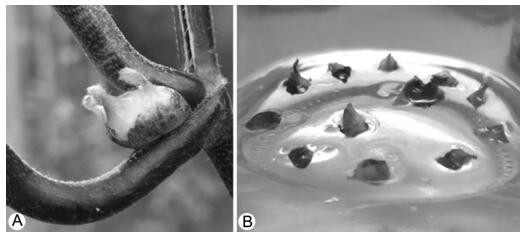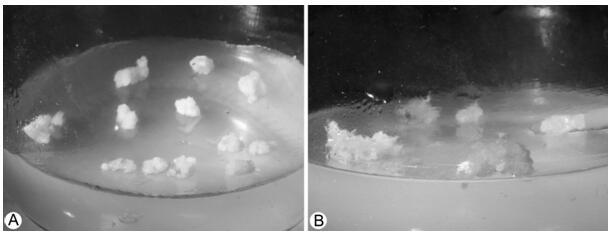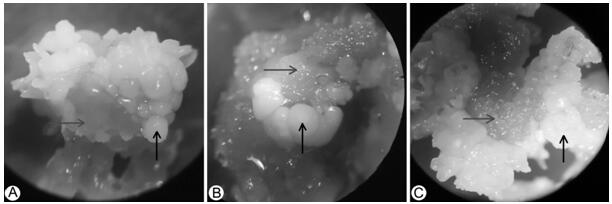Inducing culture method of Aconitum vilmorinianum Kom. embryoid
A cultivation method and technology of embryoid bodies, which are applied in horticultural methods, botanical equipment and methods, plant regeneration, etc., and can solve problems such as shortage of seedlings
- Summary
- Abstract
- Description
- Claims
- Application Information
AI Technical Summary
Problems solved by technology
Method used
Image
Examples
Embodiment 1
[0021] Embodiment 1: The method for culturing the embryoid body of Aconitum aconitifolia provided by this embodiment comprises the following steps:
[0022] (1) Selection of bulbils: Select Aconitum aconitifolia plants that grow robustly, and cut young bulbils between the leaf axils as explants ( figure 1 A);
[0023] (2) Bulb disinfection: Sterilize the Aconitum japonica selected in step (1) in 75% ethanol for 30 seconds, wash it with sterile water for 5 times, and then put it in 0.1% HgCl 2 Disinfect in the solution for 10 minutes, then wash 5 times with sterile water, and dry the water with sterile paper;
[0024] (3) Callus induction: such as figure 1 As shown in B, insert the Aconitum aconitum sterilized in step (2) into solid medium (2,4-dichlorophenoxyacetic acid 2.0mg / L, KT 0.5mg / L, PVP 1.5g are added to MS medium / L, agar 5.0g / L, sucrose 20g / L, medium pH value 5.8), cultured under the conditions of culture temperature 25℃, light 12h per day, and light intensity 3...
Embodiment 2
[0027] Embodiment 2: The method for culturing the embryoid body of Aconitum aconitifolia provided by this embodiment comprises the following steps:
[0028] (1) Selection of bulbils: Select the vigorously growing plants of Aconiti japonica, and cut the tender bulbils between the leaf axils as explants;
[0029] (2) Bulb disinfection: Sterilize the Aconitum japonica selected in step (1) in 75% ethanol for 60 seconds, wash it with sterile water for 6 times, and then put it in 0.1% HgCl 2 Disinfect in the solution for 15 minutes, then wash 5 times with sterile water, and dry the water with sterile paper;
[0030](3) Callus induction: insert the sterilized Aconitum aconitifolia buds in step (2) into solid medium (add 2,4-D 1.5mg / L, KT 0.3mg / L, PVP 1.5g to MS medium / L, agar 5.5g / L, sucrose 30g / L, medium pH value 5.8), cultured under conditions of culture temperature 25℃, light 12h per day, and light intensity 3500lx. rate of 0%, browning rate of 0%, callus induction rate of 87.2...
Embodiment 3
[0033] Embodiment 3: The method for culturing the embryoid body of Aconitum aconitifolia provided by this embodiment comprises the following steps:
[0034] (1) Selection of bulbils: Select the vigorously growing plants of Aconiti japonica, and cut the tender bulbils between the leaf axils as explants;
[0035] (2) Bulb disinfection: Sterilize the Aconitum japonica selected in step (1) in 75% ethanol for 50 seconds, wash it with sterile water for 4 times, and then put it in 0.1% HgCl 2 Disinfect in the solution for 12 minutes, then wash 6 times with sterile water, and dry the water with sterile paper;
[0036] (3) Callus induction: insert the sterilized Aconitum aconitifolia buds in step (2) into solid medium (add 2,4-D 1.0mg / L, KT 0.1mg / L, PVP 1.5g to MS medium / L, agar 6.0g / L, sucrose 35g / L, medium pH value 5.8), cultured under conditions of culture temperature 23℃, light 10h per day, and light intensity 3000lx. rate of 0%, browning rate of 0%, callus induction rate of 62....
PUM
 Login to View More
Login to View More Abstract
Description
Claims
Application Information
 Login to View More
Login to View More - R&D
- Intellectual Property
- Life Sciences
- Materials
- Tech Scout
- Unparalleled Data Quality
- Higher Quality Content
- 60% Fewer Hallucinations
Browse by: Latest US Patents, China's latest patents, Technical Efficacy Thesaurus, Application Domain, Technology Topic, Popular Technical Reports.
© 2025 PatSnap. All rights reserved.Legal|Privacy policy|Modern Slavery Act Transparency Statement|Sitemap|About US| Contact US: help@patsnap.com



